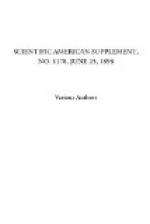* * * * *
WILD AND DOMESTIC SHEEP IN THE BERLIN ZOOLOGICAL GARDEN.
As a rule, domestic animals are accorded very little space in zoological gardens, but, although it is doubtless the first duty of these popular institutions to show visitors animals which live in a wild state in foreign lands, it is well, where there is sufficient space and adequate means, to extend the limits of the collection so as to include natives of our own woods and fields, thus enabling people of a great city who are unfamiliar with nature to form an idea of the changes wrought in animal life by the influence of man, for domestic animals are a great aid in the study of natural history. The accompanying engravings are reproductions of instantaneous photographs of occupants of the new sheep and goat house—mostly foreign breeds; but there are a few that belong to that South European-Asiatic group which are looked upon as the progenitors of the domestic sheep: the mouflon, of Sardinia and Corsica (Ovis Musimon L.), which has a coat of brownish red, flecked with darker color; and the slender, long-legged, reddish-gray sheep of Belochistan (Ovis Blanfordi Hume). The first glance at these creatures convinces one that they are wild, not domestic sheep, an impression which is caused chiefly by the monotonous coloring and the dry, short coat, which bears no resemblance to the thick fleece of the tame sheep, although the eye is soon attracted by other differences, such as the shape of the tail, which is short and thick, and of the horns, which extend over the back and then turn inward, so that when the old ram is kept in captivity, it is necessary to cut off the points of the horns to prevent their boring into the flesh of its neck. Horns of this shape form a strong contrast to those with snail-like windings and points standing away from the body. When looking at one of these sheep from the front, it will be noticed that the left horn turns to the right and the right horn to the left.
[Illustration: Sardinian mouflon (Ovis Musimon L.)]
[Illustration: Belochistan sheep (Ovis Blanfordi Hume).]
Former authorities have been unwilling to admit that the domestic sheep have come from any species of wild sheep of the present time. They hold that they are the descendants of one or more species of wild sheep that are now extinct. Recently, however, men have thought more deeply and freely on such subjects, and Nehring and others have traced the modern tame sheep back to the mouflon, but not to him alone. It is thought that in this case, as with other domestic animals, there has been a mixture of species, and in this connection attention was directed to the Transcaspian arkal, the argalis of the interior of Asia and the North African species. Dr. Heck, director of the Berlin Zoological Garden, thinks that the horns of the tame ram, which are turned outward, the points being directed away from the body, constitute one of the strongest proofs that the blood of the argalis and its extinct European ancestors—which are known only by the fossil remains—flows in the veins of all domestic sheep.




